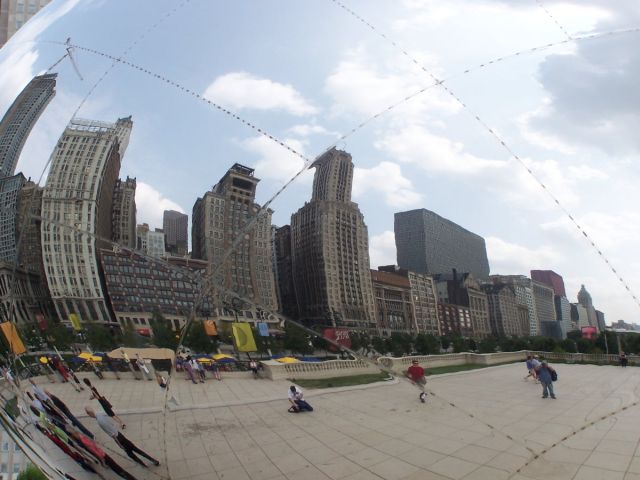
Millenium Bean 1 by Terry
| Geology along Chicago's
Michigan Avenue
|
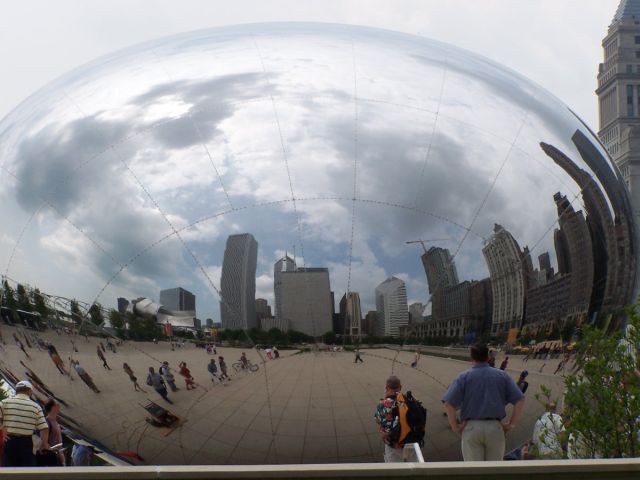
Millenium Bean 2 by Terry
|
|
This handout is for a walking tour of both sides of Michigan Avenue. We will walk the east part first, pointing out the buildings and features on both sides of the street. However, our detour into Chicago's New East Side means that we skip part of Michigan Avenue at the beginning of the trip.
|
Start at the Chicago's Cultural Center
- Chicago Cultural Center (1897) 78 E. Washington Street. This Italian Renaissance style building is faced with a Stone Mountain, Georgia granite base course breaking off in thin flakes. This intrusive igneous rock naturally exfoliates in thin flakes, but excessive city flaking is due to road salt. Above the granite base course, the building is faced in limestone. Inside are reported to be more than 150 types of earth materials in the mosaics, wainscotings and tiles including Carrara marble and dark green Irish Conemargh Marble (which is billions of years old). Two room ceilings are backlit glass domes designed by Louis Tiffany. The CCC is a Chicago Landmark.
-
Pittsfield Building 55 E. Washington. The only real "detour" on this trip. We will see two to six-inch diameter ammonoids and one-half to one inch belemite fossils in the reddish Alpine Jurassic limestone inset into the polished brass facade. Walk back to Randolph and Michigan through Garland Court and look at the exfoliation weathering on the CCC and the Italianate window arches along this hidden street.
|
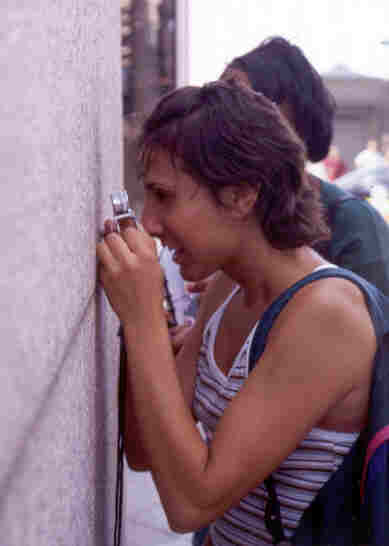
Antonia examines white granite
|
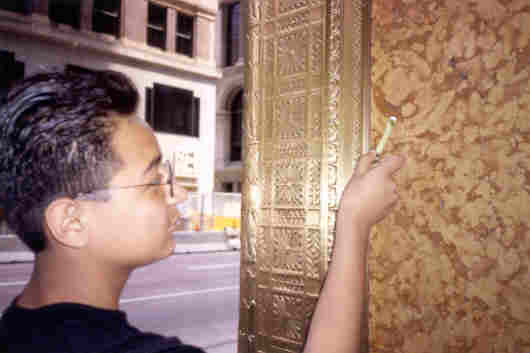
Marco points out an ammonoid
|
Marco Mendez points out an Ammonoid on 55 E. Washington (left). The Cultural Center is over his left shoulder. NEIU student Antonia Garbo examined fossiliferous limestone on the Cultural Center with a hand lens (above right). Due to the influence of acid rain, the stone on the Cultural Center and many other downtown Chicago buildings is deteriorating.
|
Chicago Caves and Canyons
-
Randolph Street Station -- Under Michigan Avenue at Randolph. Descend into Chicago's man made cave systems and watch out for calcium carbonate cave formations ("speleothems") including: stalactites, flow draperies, cave popcorn, cave needles, iron staining and iron carbonate formation. Walk
past the ticket machines and through the revolving doors to your left (north). As you go up the escalator from the Randolph Street Station, you enter Chicago's "New East Side," built entirely on air rights from the railroad. Take the next bank of escalators and walk through:
-
Prudential Buildings, I and II 130 E. Randolph and 180 N. Stetson. The original Bedford, Indiana limestone facade was replaced with granite due to weathering and potential for failure due to weathering. A new frame system was put in place to support the additional weight and the original
building slowly disappeared inside its new casing. Continue through the pedway into the:
- Aon Center = Amoco Building (1974) 200 E. Randolph and walk out into the garden at the south side of the building. In contrast to the approach being used on Prudential I, when the Carrara Marble with which the building was originally faced failed after only ten years exposure to weathering, each piece was painstakingly removed and replaced with Mt. Airy, North Carolina white granite. The grey granodiorite courses and red Italian granite courses being more expensive are used sparingly on the building and more lavishly in the plaza which also features a formal garden including many native North American plants. The Amoco Building is the second tallest building in Chicago after the Sears Tower. Anemometers control the fountains in the surrounding plaza which is also graced by a sculpture by Bertoia called Offering to the Wind. Walk north through the pedway and into:
- The athletic center was designed by Fujikawa, Johnson and Associates in collaboration with Kisho Kurokawa, a well-known Japanese architect. The original developers of the then "Sporting Club" installed a 103 foot tall climbing wall, one of the tallest artificial rock walls in the world. The distance between the street and the bottom of the rock wall is how far up Chicago has been raised since 1835. Leave the club by the Stetson Street door and cross the street into:
-
Illinois Center 233 N. Michigan. The three buildings in this modern complex share a bronze finish with tinted glass. In the lobby is a magnificently mounted green marble wainscoting. Each piece and counterpiece are matched in pairs. The buildings are built on air rights from the Illinois Gulf
Central Railroad which maintains its corporate headquarters here. Look across Michigan to see the:
-
Carbide and Carbon Building (1929) 230 North Michigan which we will see close up on our return trip. While many Art Deco buildings in Chicago employ a dark intrusive igneous rock base ("black granite," actually basalt or gabbro) with light gray Bedford, Indiana limestone above, the Burnham Brothers Architects used a dark stone base surmounted by dark terra-cotta highlighted with bronze and gold terra-cotta trim. The C and C Building is a Chicago Landmark. Go as far north as you can in the Illinois Center plazas, down the stairs at Wacker Drive and:
|
Return to Michigan Avenue
- 333 North Michigan Avenue (1928) Designed by Holabird and Root, this Chicago Landmark stands at the southeast corner of Michigan and Wacker. The bottom four stories of this Art Deco building are faced in what appears to be Cold Spring, Minnesota "granite" such as was used on the Adler Planetarium and several other downtown Chicago buildings. This base stone is often mislabeled "polished marble" in local architectural books. Above this is the more customary Bedford Limestone. These materials mirrored the Corinthian influenced 360 N. Michigan across the street. The latter building was originally named the London Guarantee Building. It was finished in 1923, designed by Alfred S. Alschuler, and is also a Chicago Landmark. The street outside this building is marked with bronze placques showing the "original site of Fort Dearborn" but they forget to tell you it was fifty feet below the pavement.
- The Michigan Avenue Bridge (1918-1920) is a double-leaf trunion bascule bridge with two traffic decks, the lower one is currently closed to vehicular traffic due to the North Michigan Avenue Reconstruction Project. The four bridge towers have sculptural pieces and plaques commemorating events in Chicago history. The Bedford limestone of the bridge piers has silicified sponges, bryozoa, gastropods, ammonoids and other fossils. The Michigan Avenue Bridge and the Wacker Drive Esplanade are Chicago Landmarks.
- The flow of the Chicago River was reversed in 1900. A series of locks and dams permit boats to travel from the river to Lake Michigan, but restrict the lakeward flow of the river which now flows downstream through the 28-mile long Sanitary and Ship Canal to the Illinois River and eventually to the Gulf of Mexico. Learn more about the Chicago River by visiting The Friends of the Chicago River website.
|
The Magnificent Mile
- Wrigley Building (1921, 1924) 410 N. Michigan. Graham, Anderson, Probst and White modeled this skyscraper after the cathedral in Seville, Spain. Within the last five years, the famous Wrigley clock-tower which tops the brilliant white terra-cotta has been fully restored. The huge wooden hands of the clocks were removed and replaced to prevent damage during a restoration of the building's exterior to correct flaws in the terra-cotta due to weathering.
|
- The Tribune Tower (1923-1925) 435 N. Michigan.
The Gothic revival design for this building was selected based on an architectural competition won by John Mead Howells and Raymond M. Hood. Modeled in Indiana limestone, the design is based on the Butter Tower of Rouen Cathedral, with delicate stone tracery and a fine collection of individualistic gargoyles. The medieval atmosphere is heightened by Colonel McCormick's collection of stones from famous buildings around the world. The limestones used for the Tower are fossiliferous: trilobites, brachiopods, mollusks, gastropods, sponges, and bryozoa have been identified so far. The Tribune Tower is a Chicago Landmark.
|
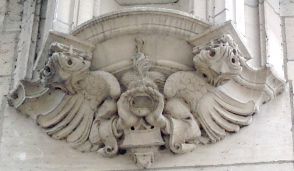
News
Colonel McCormick, publisher of the Tribune when the building was built, " believed in `paying homage to the power and financial strength of the American press while its exterior decoration pokes fun at the role of the press and the society in which it funcions,'" according to Terry who took these pictures of the Tribune Tower gargoyles. He writes, the credit for the idea for these pics and the meaning behind the iconography as well as the quote above goes to Darlene Trew Crist and her book "American Gargoyles Spirits in Stone."
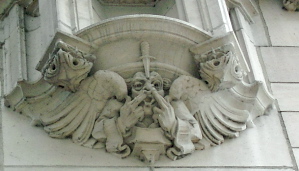
Rumor
|
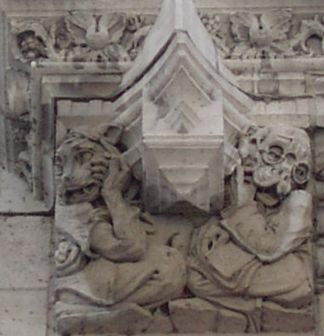
Radicalism (the wolf) and Conservatism (the passive dog)
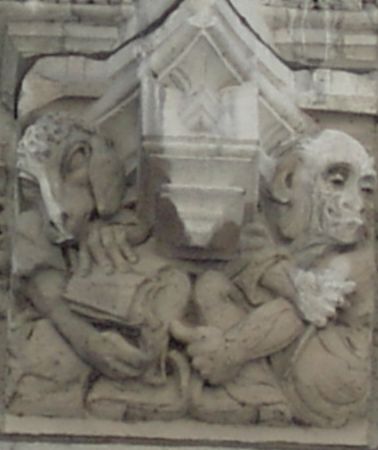
Citizens (law abiding sheep) and Anarchy (gorilla with a dagger)
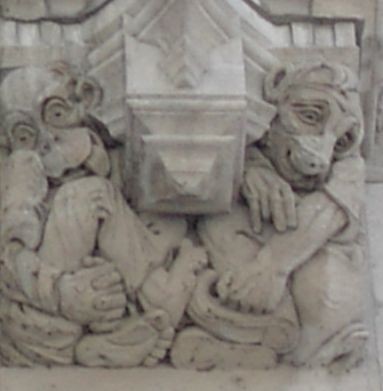
Activity (the hyper monkey) and Indolence (the placid bear) |
- Intercontinental Hotel (1927-1929) 505 N. Michigan. Built as the Medinah Athletic Club and converted in the 1980s to a hotel, the base of this building shows deep salt fretting. The upper part of the building is faced in Indiana limestone.
- 625 North Michigan. The lower part is faced in polished Rapakiwi granite from Finland. The granite has large round crystals and is thus called "orbicular granite" by geologists.
- Neiman-Marcus, 737 N. Michigan Avenue. This massive arch perhaps a post-modern gesture to Richardson Romanesque, is faced in red granite which is alternately polished and honed.
- 777 N. Michigan Avenue. This modern slab building rises from a black norite and marble base.
- Chicago Water Tower and Pumping Station (1869, William W. Boyington, architect) One of only a few survivors of the 1871 Great Chicago Fire, the Water Tower and accompanying pumping station were described by an English traveler:
"Never were so many cupolas and buttresses, pinnacles and towers grouped together on one spot; none but a true artist could have arranged them into so harmonious a whole." However Oscar Wilde, after visiting the Windy City in 1882, wrote: "[It's a] castellated monstrosity with pepper boxes stuck all over it."
The Water Tower is built of Illinois Limestone (probably Joliet or Sugar Run formation). This stone was widely used by early settlers but was supplanted by Indiana limestone due to durability issues. The Illinois limestones are more yellow in color, the Indiana limestones are light grey to white when newly cut. The fire house behind the pumping station was built to complement the water tower group and was finished in 1904 by C.F. Hermann. All three buildings are Chicago Landmarks.
- Chicago Water Tower Place, Michigan Avenue and Chestnut (1976) A long list of mid seventies architects contributed to this "radiant city" masterpiece. The inside is actually much more interesting than the featureless, monolithic exterior. However, the architects chose a thick slab marble for the exterior. Now buckling and failing these marble slabs attest to the powers of nature; in this case gravity and dissolution of the carbonate marble by rain. All rain is slightly acid due to the tendency of carbon dioxide and water to recombine to carbonic acid
(H2O + CO2 --- H2CO3).
Adding exhaust from thousands of buses, cars, street washers, motorcycles and other sources merely adds to the acidity of local rain and the speed of rock weathering.
- Fourth Presbyterian Church and Parish House (1912, 1925) 125 East Chestnut Street. Ralph Adams Cram and Howard Van Doren Shaw designed these lovely Gothic Revival buildings which were built from grey Indiana limestone. Don't miss the cloistered walk and the fountain. Just steps away from the bustle and hurry of Michigan Avenue, yet worlds away in sense of place and serenity. The top of the spire is 122 feet above Michigan Avenue.
- John Hancock Center (1969) 875 N. Michigan. Skidmore, Owings and Merrill designed this multiuse skyscraper for retail, commercial, office, residential, broadcast and tourism uses. The top has a skydeck observatory open to the public from 9 a.m. to midnight daily. Inside the lobby is a hot springs travertine marble. In the plaza is a magnificent basalt waterfall surrounded by a large feldspar granite on the stairs and seating walls.
|
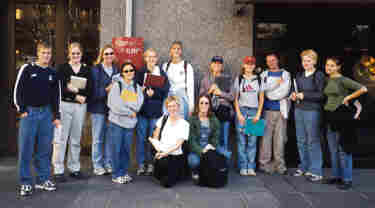
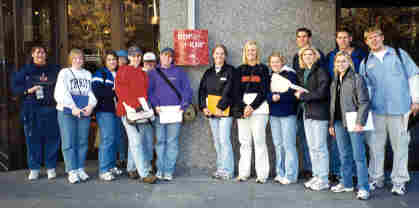
Trinity Christian College Geography students at the John Hancock Building, Chicago. Fall, 2000.
|
Reference material to prepare for the field trip. |
|---|
Geological Illustrations
Standard rock symbols .
Complete Geologic Column .
Ordovician fossils .
Silurian fossils .
Devonian fossils .
Mississippian fossils .
Pennsylvanian fossils .
Illinois top of rocks map .
LaSalle and Kanakakee geological column .
LaSalle area cross-section .
Northern Illinois top of rocks map
|










